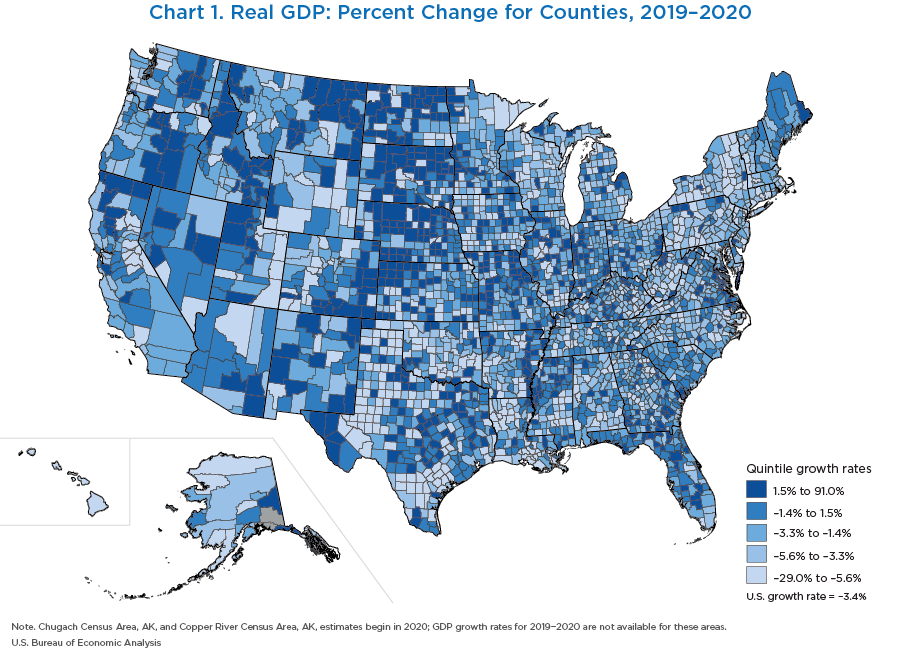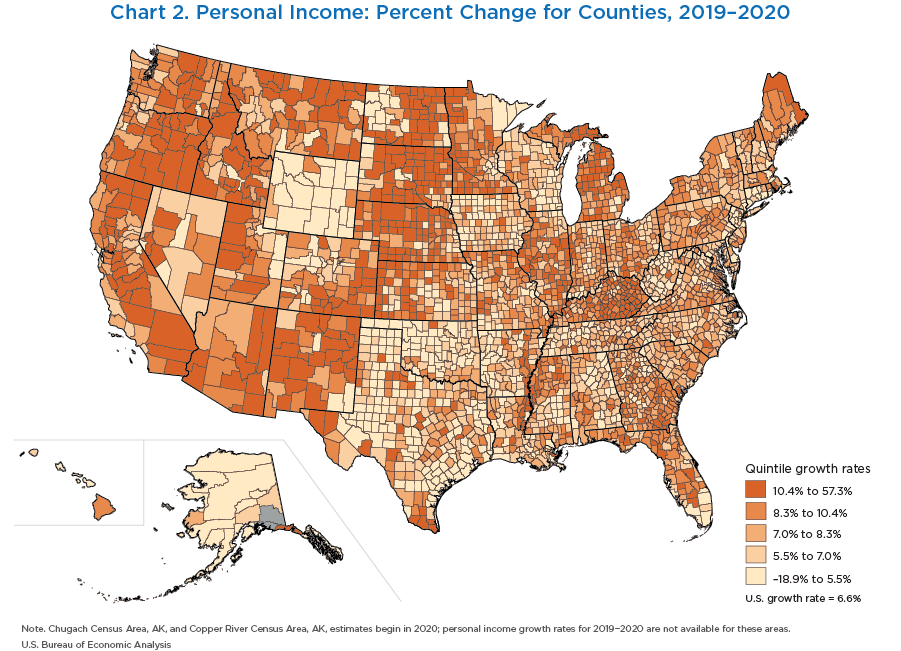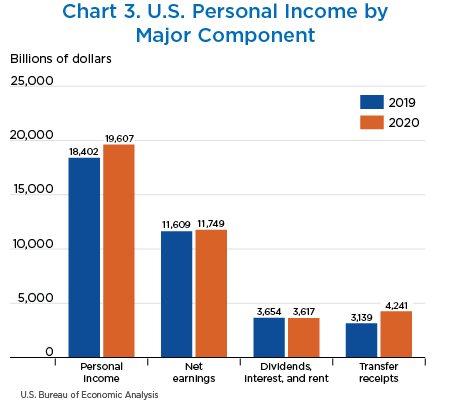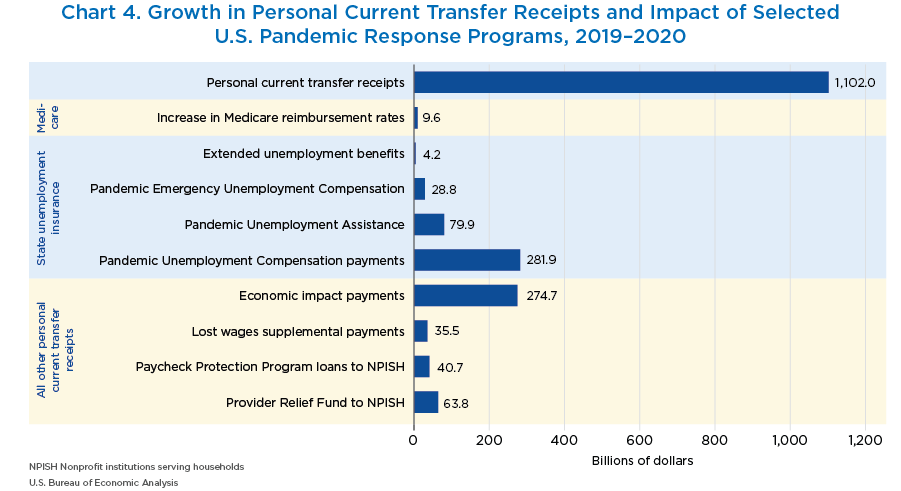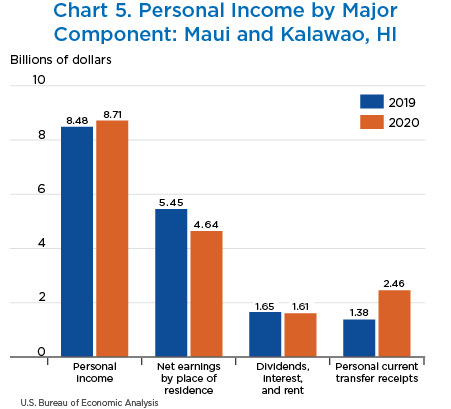New and Updated County Statistics
GDP for 2020 and 2001–2019 and Personal Income for 2020 and 1998–2019
On December 8, 2021, the Bureau of Economic Analysis (BEA) released gross domestic product (GDP) statistics by county for 2020 and updated GDP statistics for 2001–2019. On November 16, 2021, BEA released personal income statistics by county for 2020 and updated personal income statistics for 1998–2019. These annual county estimates incorporate the results of the July 2021 annual revision to the National Income and Production Accounts (NIPAs), the September 2021 annual update to the personal income by state estimates, and the October 2021 annual update to the GDP by state estimates.
GDP by county measures the value of goods and services produced within a county.1 Personal income by county measures the income received by, or on behalf of, all persons from all sources within a county.2 Sources of income include participation as laborers in production and income from owning a home or business, ownership of financial assets, and transfers from government and business, whether such source of income is foreign or domestic. Not included in personal income are realized or unrealized capital gains or loses. Conceptually, GDP is by place of work, whereas personal income is by place of residence. The key difference between GDP and personal income is that corporate income and taxes on production and imports less subsidies are only included in GDP, while personal dividend and interest income and personal current transfer receipts are only included in personal income.
Real GDP decreased 3.4 percent in 2020 after increasing 2.3 percent in 2019. Real GDP by county across the United States ranged from $18.8 million in Petroleum County, MT, to $659.3 billion in Los Angeles County, CA. Real GDP increased in 864 counties, decreased in 2,234 counties, and was unchanged in 14 counties in 2020. The percent change in real GDP ranged from 91.0 percent in Foard County, TX, to
Personal income increased 6.6 percent in 2020 after increasing 4.1 percent in 2019. Personal income by county ranged from $8.9 million in Loving County, TX, to $678.8 billion in Los Angeles County, CA. Personal income in 2020 increased in 3,040 counties, decreased in 69 counties, and remained unchanged in 3 counties. The percent change in personal income ranged from 57.3 percent in Clark County, SD, to
Real GDP in the United States declined by 3.4 percent in 2020, while personal income increased 6.6 percent, as the country faced economic impacts due to the COVID-19 pandemic. The pandemic's impact and the response to it varied by region and jurisdiction over time. County-level statistics for GDP and personal income are aggregated across the year, however, which presents a challenge for analyzing the impact of the COVID-19 pandemic on both county statistics. For analysis purposes, therefore, it is useful to approach the data at an industry level for GDP and an income-type level for personal income.
Real GDP
Table 1 presents real value added by industry at the national level for 2019 and 2020. The largest declines in 2020 were in mining (which includes oil and gas extraction); transportation and warehousing; arts, entertainment, recreation, accommodation, and food services; and other services except government. Within mining, the largest decline was in support activities for mining. Within transportation and warehousing, the largest decline was in air transportation. Within arts, entertainment, recreation, accommodation, and food services, the largest decline was in food services and drinking places; significant declines also occurred in performing arts, spectator sports, museums and related services, and accommodation.
| Industrial sector | Year | Percent change | |
|---|---|---|---|
| 2019 | 2020 | ||
| Agriculture, forestry, fishing, and hunting | 223.3 | 254.7 | 14.0 |
| Mining | 488.3 | 438.6 | −10.2 |
| Utilities | 286.6 | 298.6 | 4.2 |
| Construction | 674.7 | 650.4 | −3.6 |
| Manufacturing | 2,233.9 | 2,167.8 | −3.0 |
| Wholesale trade | 1,104.6 | 1,083.9 | −1.9 |
| Retail trade | 1,122.9 | 1,090.5 | −2.9 |
| Transportation and warehousing | 566.1 | 490.3 | −13.4 |
| Information | 1,252.9 | 1,296.5 | 3.5 |
| Finance, insurance, real estate, rental, and leasing | 3,558.2 | 3,568.6 | 0.3 |
| Professional and business services | 2,543.8 | 2,483.9 | −2.4 |
| Educational services, health care, and social assistance | 1,666.4 | 1,560.5 | −6.4 |
| Arts, entertainment, recreation, accommodation, and food services | 734.9 | 516.2 | −29.8 |
| Other services, except government | 368.8 | 323.0 | −12.4 |
| Government | 2,216.3 | 2,195.5 | −0.9 |
Note. Chained (2012) dollar series are calculated as the product of the chain-type quantity index and the 2012 current-dollar value of the corresponding series, divided by 100. Because the formula for the chain-type quantity indexes uses weights of more than one period, the corresponding chained-dollar estimates are usually not additive.
Table 2 shows the 10 largest declines in real GDP by county for 2020. The largest was in Skagway Municipality, AK.3 The county has a population of 1,179, making it the third smallest in the state by population. Its port is a popular stop for cruise lines. While cruise companies' economic activity is not reported within the county, much of the county's economic activity is related to tourism. Reduced tourism resulted in economic declines across Skagway's largest industries.
| County | 2019–2020 |
|---|---|
| Skagway Municipality, AK | −29.0 |
| Dimmit, TX | −28.7 |
| McMullen, TX | −28.1 |
| King, TX | −27.1 |
| Karnes, TX | −25.4 |
| Ward, TX | −25.2 |
| Stonewall, TX | −24.6 |
| Clayton, GA | −24.3 |
| Jim Wells, TX | −24.3 |
| Mingo, WV | −24.3 |
Of the 10 largest county declines in GDP, 7 are in Texas, in different regions of the state. In all seven counties, the largest contribution to percent change in real GDP came from declines in mining. Oil production declined across the United States following the steep drop in world oil prices in April 2020. At the same time, the largest increase in county GDP also occurred in Texas and was related to energy production. Foard County (population 1,135) is the site of the Foard City Wind Project. This wind farm, which came online in late 2019, is classified in the utilities sector. The utilities sector accounted for 81 percent out of the 91 percent total change in real GDP in Foard County.
Relationship between GDP and personal income
As mentioned previously, some of the key differences between GDP and personal income are that GDP, unlike personal income, includes (1) elements of gross operating surplus, including corporate profits, and (2) taxes on production and imports less subsidies, while personal income instead includes (1) personal dividend and interest income and (2) personal current transfer receipts. In 2020, real GDP decreased by 3.4 percent, while personal income increased by 6.6 percent. This difference in growth between GDP and personal income can be explained by the differences in their composition.
Table 3 lays out the relationship between nominal GDP and personal income on a national level.
| Components | GDP 1 | Personal Income 2 |
|---|---|---|
| Compensation of employees | 124.4 | 124.4 |
| Wages and salaries | 120.6 | 120.6 |
| Supplements to wages and salaries | 3.9 | 3.9 |
| Less: Rest of the world (compensation of employees) | 3.8 | - |
| Taxes on production and imports less subsidies | −686.1 | - |
| Gross operating surplus | 86.7 | - |
| Proprietors' income 3, 4 | 51.1 | 51.1 |
| Corporate profits 3, 4, 5 | −65.4 | - |
| Rental income of persons 4 | 19.5 | 19.5 |
| Other | 81.4 | - |
| Personal current transfer receipts | - | 1102.0 |
| Personal income receipts on assets | - | −55.9 |
| Personal dividend income | - | −18.2 |
| Personal interest income | - | −37.7 |
| Less: Contributions for government social insurance 5 | - | 38.0 |
| Total | −478.8 | 1,203.2 |
- Data refer to nominal gross domestic product.
- The measure of personal income in the National Income and Product Accounts is usually higher than in the Regional Economic Accounts. The former encompass a broader concept of residency while the latter excludes, for example, personal income earned by federal civilian and military personnel stationed abroad and U.S. citizens living abroad for less than one year.
- Statistics include inventory valuation adjustment.
- Statistics include capital consumption adjustment.
- Statistics are limited to domestic industries or contributions.
Nominal GDP in 2020 decreased $478.8 billion from the previous year at the national level, while personal income increased $1.2 trillion. Of all the components listed, personal current transfers receipts had the largest change, with a $1.1 trillion increase. Since personal current transfer receipts is not included in GDP but is included in personal income, it serves as the primary driver for the increase in personal income from 2019 to 2020.
Personal income
Personal income can be broken down into three components: (1) net earnings, which include wages and salaries, proprietors' income and employer contributions to employee pension and insurance funds; (2) personal dividends, interest, and rent, and (3) personal current transfer receipts. Chart 3 illustrates the breakdown of the increase in personal income from 2019 to 2020.
In 2020, personal income increased from $18.4 trillion to $19.6 trillion, an increase of $1.2 trillion. Net earnings increased $139.9 billion; personal dividends, interest, and rent decreased by $36.5 billion; and personal current transfer receipts increased by $1.1 trillion. Personal current transfer receipts contributed 91.4 percent to the growth in personal income.
The increase in personal current transfer receipts can be explained by the effects of several federal COVID-19 pandemic response programs, many of which were established under the Coronavirus Aid, Relief, and Economic Security Act. See Table 4 for an overview of the programs involved. For additional information, see also “Federal Recovery Program and BEA Statistics.”
| Component | Program |
|---|---|
| Medicare | Increase in Medicare reimbursement rates1 |
| State unemployment insurance | Extended unemployment benefits2 |
| Pandemic Emergency Unemployment Compensation2 | |
| Pandemic Unemployment Assistance2 | |
| Pandemic Unemployment Compensation payments2 | |
| All other personal current transfer receipts | Economic impact payments3 |
| Lost wages supplemental payments4 | |
| Paycheck Protection Program loans to nonprofit institutions serving households (NPISH)5 | |
| Provider Relief Fund to NPISH6 |
- A 2 percent reduction in reimbursements paid to Medicare service providers that went into effect in 2013 was initially suspended by the Coronavirus Aid, Relief, and Economic Security Act. The resulting increased reimbursement rates went into effect May 1, 2020.
- The Frequently Asked Question, “How will the expansion of unemployment benefits in response to the COVID-19 pandemic be recorded in the NIPAs?” is available on BEA's website.
- The Frequently Asked Question, “How are federal economic impact payments to support individuals during the COVID-19 pandemic recorded in the NIPAs?” is available on BEA's website.
- The Federal Emergency Management Agency was authorized to make payments from the Disaster Relief Fund to supplement wages lost as a result of the COVID-19 pandemic.
- The Frequently Asked Question, “How does the Paycheck Protection Program impact the national income and product accounts (NIPAs)?” is available on BEA's website.
- The Department of Health and Human Services distributes money from the Provider Relief Fund to hospitals and health care providers on the front lines of the coronavirus response. This funding supports health care-related expenses or lost revenue attributable to COVID-19 and ensures uninsured Americans can get treatment for COVID-19. In the NIPAs, funds provided to nonprofit hospitals are recorded as social benefits.
Chart 4 illustrates how these programs impacted the growth of personal current transfer receipts from 2019–2020.
The components that contributed the most to the $1.1 trillion increase in personal current transfer receipts were the Pandemic Unemployment Compensation payments under state unemployment insurance, which increased $281.9 billion, and economic impact payments, which contributed $274.7 billion to the increase in all other personal current transfer receipts. Overall, a significant portion of the national growth in personal current transfer receipts can be attributed to the effects of pandemic response legislation. Maui & Kalawao County, HI, encapsulates how the increase in personal current transfer receipts offset declines caused by the COVID-19 pandemic.
Maui & Kalawao County real GDP decreased 20.4 percent in 2020 due to declines in the tourism, accommodation, and food service industries during the pandemic. Meanwhile, personal income in Maui & Kalawao County increased 2.7 percent from $8.48 billion in 2019 to $8.71 billion in 2020 (chart 5). This is notable because, despite the county's decrease in real GDP, personal income increased. Net earnings decreased 14.8 percent from $5.45 billion to $4.64 billion. Personal dividends, interest, and rent decreased 2.0 percent from $1.65 billion to $1.61 billion. However, personal current transfer receipts increased 77.4 percent from $1.38 billion to $2.46 billion. It ranks as the county with the fifth-highest growth rate in the nation for personal current transfer receipts.
Personal current transfer receipts in Maui & Kalawao County grew by $1.1 billion in 2020 from the previous year (chart 6). Unemployment insurance compensation, which increased $742.9 million, was the primary contributor to the increase. Other transfer receipts of individuals from governments, which increased $203.3 million, was the second largest contributor to the increase. Like its impact on the national figures, pandemic-related legislation contributed to these increases at the county level. Most of the growth in unemployment insurance compensation was due to the various COVID-19-related unemployment insurance benefits, while growth in other transfer receipts of individuals was driven by programs such as economic impact payments and lost wages supplemental payments.
Included with the release of 2020 statistics of GDP and personal income by county were two significant improvements to the estimation methodologies for both sets of statistics. One improvement affected the estimation of housing services, and the other improvement impacted the estimation of military wages. Both changes involved the incorporation of new data sources. Additionally, new and revised data were incorporated into the estimates where available, in both the new 2020 estimates and the updated estimates for earlier years.
Methodology improvements
The improvement to the measurement of housing services involved incorporating microdata for U.S. housing units from the annual American Community Survey (ACS) produced by the U.S. Bureau of the Census, which replaced the long-form decennial census questions on housing. The ACS data have several advantages for improving the accuracy of the housing services estimates. ACS data are inclusive of all categories of housing (that is, owner, tenant, permanent site, mobile, farm, and nonfarm), so they provide a single statistical source that allows estimates to be made for individual housing units and then aggregated directly to national and state levels. ACS data are a large nationally and regionally representative sample with regional information, so they can facilitate a fully integrated approach to estimating housing services across BEA's national and regional programs. Finally, ACS data support a stratified rental equivalence methodology for imputed owner-occupied housing services, which is a transparent methodology that is favored by statistical agencies for practical purposes and is used by the Bureau of Labor Statistics to construct the Consumer Price Index for owners' equivalent rent.4 GDP estimates were revised back to 2001, and personal income estimates were revised back to 1998.
The improvement to the measurement of military wages involved incorporating data provided by the Defense Manpower Data Center. The Defense Manpower Data Center is the authoritative source for personnel and financial data for the Department of Defense. The new data and methodology provides greater efficiency and consistency across all five military services. Previous estimates relied on strength data provided by contacts at each of the five service branches. The new methodology was implemented back to 2016, impacting both the GDP and personal income estimates at the state and county levels.
Data—GDP by county
In October 2021, BEA revised its annual GDP by state estimates from 2001 to 2019 to incorporate the annual revision of the NIPAs in July, the annual revisions of the GDP by industry and personal income by state statistics in September, and new and revised source data that are more complete and more detailed than previously available. In December, BEA incorporated the October updates to the GDP by state statistics to revise the GDP by county statistics and to publish the 2020 GDP by county estimates. The December release of GDP by county estimates was also an opportunity for BEA to incorporate new and revised county-level source data.
Revised source data for GDP by county included 2016–2019 Quarterly Census of Employment and Wages (QCEW) data published by the U.S. Bureau of Labor Statistics; airline statistics from the Bureau of Transportation Statistics; and net electricity generation data the U.S. Energy Information Administration. Several sources, including QCEW, additionally had new data for 2020. Table 5 lists the updated data sources used to estimate GDP by county and the years updated. The table also includes new data sources that were introduced as part of methodological improvements.
| Data | Source | Years updated |
|---|---|---|
| Quarterly Census of Employment and Wages | U.S. Bureau of Labor Statistics | |
| Local area personal income | Bureau of Economic Analysis | |
| National Establishment Time Series | Dun & Bradstreet | 2001–2018; 20191 |
| Net electricity generation data | Energy Information Administration | 2019; 20201 |
| Coal production | Energy Information Administration | 20201 |
| Value of Construction Put in Place | Dodge Data & Analytics, LLC | 2005–2019; 20201 |
| Oil and gas production | DrillingEdge | 2001–2019; 20201 |
| U.S. Airline Financial Data (Schedule P-1.2) | Bureau of Transportation Statistics | 2019; 20201 |
| U.S Air Carrier Traffic Statistics (T-100 Domestic and International Segments) | Bureau of Transportation Statistics | 2019; 20201 |
| Carload Waybill Sample | Surface Transportation Board | 20191 |
| Summary of Bank Deposits | Federal Deposit Insurance Corporation | 20201 |
| International banking facilities deposits | Federal Reserve Bank of Chicago | 20201 |
| American Community Survey, 1-year Public Data Microdata Sample file | U.S. Bureau of the Census | 2001–2019 |
- Newly-available data were obtained for the most current year.
Data—personal income by county
In September 2021, BEA revised its preliminary annual personal income by state estimates from 1998 to 2019 to incorporate the annual revision of the NIPAs in July and new and revised source data that are more complete and more detailed than previously available. In November, BEA incorporated the September updates to personal income by state statistics to revise the personal income by county statistics and to publish the 2020 personal income by county estimates. The November release of personal income by county estimates was also an opportunity for BEA to incorporate new and revised county-level source data.
Revised source data for personal income by county included 2016–2019 data from the QCEW; 2017 Census of Agriculture data from the U.S. Department of Agriculture; and veterans benefits data from the U.S. Department of Veterans Affairs. Several sources, including QCEW, additionally had new data for 2020. Table 6 lists the updated data sources used to estimate personal income by county and the years updated. The table also includes new data sources that were introduced as part of methodological improvements.
| Data | Source | Years updated |
|---|---|---|
| Quarterly Census of Employment and Wages | U.S. Bureau of Labor Statistics | |
| Census of Agriculture | National Agricultural Statistics Service, U.S. Department of Agriculture | 20171 |
| Statistics of Income | Internal Revenue Service | 20191 |
| Veterans pension, disability, life insurance, and readjustment benefits data; number of pension and disability beneficiaries | U.S. Department of Veterans Affairs | 2016–2019; 20201 |
| Medicare Advantage fee-for-services expenditure data; enrollment data for Medicare hospital insurance, Supplement Health Insurance, and Medicare Parts B and D | Centers for Medicare and Medicaid Services | 20201 |
| American Community Survey, 1-year Public Data Microdata Sample file | U.S. Bureau of the Census | 2001–2019 |
| Military strength by service and location | Defense Manpower Data Center, U.S. Department of Defense | 2016–2020 |
- Newly-available data were obtained for the most current year.
The updates to the personal income statistics, measured as a percentage of the previously published statistics, were modest for most counties. Compared to personal income revisions, counties experienced a higher mean absolute revision (MAR) in real GDP (table 7). This can be explained by the incorporation of the larger number of revised source data used to estimate real GDP.
| Mean absolute revision (percent) | Number of counties | |
|---|---|---|
| Revisions to real gross domestic product by county (2001–2019) | Revisions to personal income by county (1998–2019) | |
| 0.0–4.9 | 2,550 | 3,069 |
| 5.0–9.9 | 444 | 33 |
| 10.0 or greater | 119 | 10 |
The MAR to real GDP across all periods open to revision from 2001 to 2019 was 3.1 percent. MAR was less than 5.0 percent in 2,550 counties, between 5.0 and 9.9 percent in 444 counties, and equal to or greater than 10.0 percent in 119 counties.
The MAR to personal income across all periods open to revision from 1998 to 2019 was 1.0 percent. MAR was less than 5.0 percent in 3,069 counties, between 5.0 and 9.9 percent in 33 counties, and equal to or greater than 10.0 percent in 10 counties.
- See Kirubel D. Aysheshim, Jacob R. Hinson, and Sharon D. Panek, “A Primer on Local Area Gross Domestic Product Methodology,” Survey of Current Business 100 (March 2020).
- See Local Area Personal Income and Employment Methodology on the BEA website.
- Before 2008, Skagway Municipality and Hoonah-Angoon Census Area reported as Skagway-Hoonah-Angoon Census Area.
- For details, see Dylan G. Rassier, Bettina H. Aten, Eric B. Figueroa, Solomon Kublashvili, Brian J. Smith, and Jack York, “Improved Measures of Housing Services for the U.S. Economic Accounts,” Survey 101 (May 2021)
